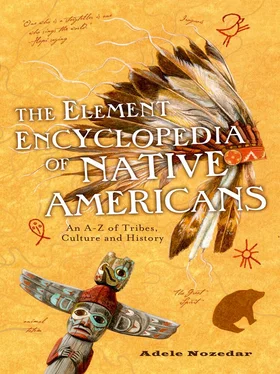1780(?)–1866
A chief of the Duwamish tribe, whose name would become immortalized for all time in the great city named after him, Seattle also became famous for one particular speech, although there is controversy as to the content, context, and precise nature of the speech.
Seattle—or Si’ahl —was born in the area of Blake Island, Washington. His mother was of the Duwamish and his father of the Suquamish. His position as chief was inherited from his maternal uncle, as was the tradition in a matrilinealtribe.
Accounts of Seattle tell us that he was tall for one of his tribe, standing at almost 6 feet; he was given the nickname Le Gros , meaning “The Big One,” by the European traders. A skilled orator, he also had the added vantage of a loud voice. He was a confident and skilled warrior, leading skirmishes against enemy peoples. It was a tradition among the Duwamish to make slaves of enemies that they captured.
Seattle’s first wife died after giving him a daughter; his second wife bore him seven children: four girls and three boys. His best-known child was his first daughter, Kikisoblu, who would become better known as Princess Angeline. In the late 1840s Seattle was baptized into the Catholic Church, taking the name of Noah Seattle.
The town of DuWamps was changed to Seattle when Chief Seattle formed an alliance with the Europeans against the Patkanim tribe, who were making incursions onto the traditional sites where the Duwamish caught clams and other shellfish.
After the Battle of Seattle in 1856, the Chief was reluctant to allow his people to relocate to the reservationthat had been allotted them, since the Snohomish, their traditional enemies, were also going to be relocated there, and Seattle knew that this would lead to conflict. Instead, his people relocated to the Suquamish reservation in Washington, where he died in 1866. He was buried at the tribal cemetery there.
The quote at the head of this entry is an extract from the controversial speech involving Seattle. Consensus of opinion says that the occasion of the speech was March 11, 1854, in the then-town of Seattle. A public meeting had been called by the governor of the town to discuss the sale of Native lands to European settlers.
Seattle was asked to speak on the subject, and here the real controversy arises. Evidently Seattle spoke with passion and at some length, in the Lushootseed tongue, which was translated into Chinookand then into English.
The speech was only written down in English some years after the event, by one Henry A. Smith, who had taken notes at the time. In Smith’s version, Seattle thanked the Europeans for their generosity, and also compared the Christian god to the Native god. Smith himself admitted that he had noted only a small part of the speech, and what he wrote is rather florid. The speech has subsequently been rewritten by others who could not possibly know what was actually said, although it has been described as “a powerful, bittersweet plea for respect for Native American rights and environmental values.”

The traditional form of weaving carried out by peoples on the northwest coasts of British Columbia and Alaska, including the Haida and the Tlingit. The Chilkat people after whom the blankets were named were a division of the Tlingit who originally lived along the river of the same name in Alaska. Chilkat blankets were worn exclusively by high-ranking tribal members at important dances and ceremonies including the potlatch.
This method of weaving is one of the most complex in the world; the artist is able to incorporate curved lines and circular shapes within the body of the weave itself. All sorts of materials are used in the fabric: dog and mountain goat hair and the bark of the yellow cedar were used traditionally, although today, sheep wool is more likely to be used. The designs are very distinctive, incorporating stylized animal designs primarily in red and black. The art of Chilkat weaving had almost been lost—in the 1990s it was estimated that only six people still practiced the art—but luckily the technique has enjoyed a revival recently.
The Chinook lived on the Columbia River in the Pacific Northwest, and were known for their fishing and trading skills. They used dugout canoesfor their fishing trips and lived in permanent wooden houses rather than, for example, the moveable tipisof the Plains Indians. In appearance they were tall; their most defining characteristic was perhaps the shape of their skulls, which were deliberately manipulated in infancy to alter their appearance. For the Chinook, a skull modified in this way was the height of good breeding, and a “normal” skull was considered to be inferior.
The Chinook language was particularly difficult to master, not only its rudiments but its pronunciation. Because of this, other tribes—and also the European fur traders—used a sort of shorthand language with the Chinook. This was known as “Chinook Jargon,” and made life easier for anyone who had to trade with the tribe, or for whom Chinook was not their mother tongue.
See Ojibwe
Belonging to the Muskhogean language family, the Choctaw were the largest tribe in that particular group. Originally they came from the southeastern U.S., including Alabama, Florida, Louisiana, and Mississippi. There are different theories as to the origin of the tribe’s name. It was possibly the name of a great chief of the tribe, possibly from a derivation of “river people,” possibly from the Spanish word chato , meaning “flat heads.” Because they allowed their hairto grow long, they were also called “long hair.”
An agricultural people, the Choctaw had a unique way of dealing with their deceased. The bones of the corpse were cleaned thoroughly and then placed in boxes which were stored in “bone houses.” The task of cleaning the bones was carried out by older men who let their fingernails grow especially long for the purpose. The Choctaw also belonged to the ancient mound-building cultures, and an ancient myth belonging to the tribe states that the people emerged from a mound in the ground, called Nanih Waiya.
In the 17th century the Choctaw arranged themselves into three independent groups: the eastern, western, and southern Choctaw. These different bands struck up different allegiances with the European settlers, although the American War of Independence saw all three Choctaw groups band together to take the side of independence against the British monarchy.
Because the Choctaw had embraced many of the practices of the white settlers, they were credited with the title of one of the Five Civilized Tribesin the 19th century. The other four tribes considered by the Europeans to be “civilized” were the Cherokee, Chickasaw, Creek, and Seminole. The Choctaw were also one of the tribes who kept slaves.
Nine treaties were made between the Choctaw and the U.S. Government; this resulted in vast tracts of former Choctaw land being ceded to the Government, and the tribe itself relocating to the Indian Territoryin Oklahoma. The Choctaw had the dubious honor of being the first Native Americans to undergo such forced removal, although they did manage to negotiate a sizeable chunk of land for themselves. One of the features of the Choctaw, which no doubt led to their “civilized” status, was their system of self-governance, which divided the tribe into three, each with its own chief. There was also a Choctaw delegate to represent the tribe at the center of the U.S. Government in Washington, D.C.
Читать дальше













